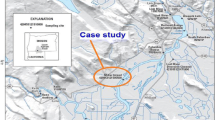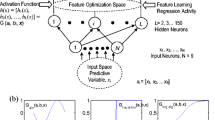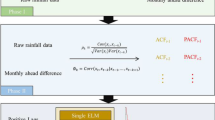Abstract
In this paper, several extreme learning machine (ELM) models, including standard extreme learning machine with sigmoid activation function (S-ELM), extreme learning machine with radial basis activation function (R-ELM), online sequential extreme learning machine (OS-ELM), and optimally pruned extreme learning machine (OP-ELM), are newly applied for predicting dissolved oxygen concentration with and without water quality variables as predictors. Firstly, using data from eight United States Geological Survey (USGS) stations located in different rivers basins, USA, the S-ELM, R-ELM, OS-ELM, and OP-ELM were compared against the measured dissolved oxygen (DO) using four water quality variables, water temperature, specific conductance, turbidity, and pH, as predictors. For each station, we used data measured at an hourly time step for a period of 4 years. The dataset was divided into a training set (70%) and a validation set (30%). We selected several combinations of the water quality variables as inputs for each ELM model and six different scenarios were compared. Secondly, an attempt was made to predict DO concentration without water quality variables. To achieve this goal, we used the year numbers, 2008, 2009, etc., month numbers from (1) to (12), day numbers from (1) to (31) and hour numbers from (00:00) to (24:00) as predictors. Thirdly, the best ELM models were trained using validation dataset and tested with the training dataset. The performances of the four ELM models were evaluated using four statistical indices: the coefficient of correlation (R), the Nash-Sutcliffe efficiency (NSE), the root mean squared error (RMSE), and the mean absolute error (MAE). Results obtained from the eight stations indicated that: (i) the best results were obtained by the S-ELM, R-ELM, OS-ELM, and OP-ELM models having four water quality variables as predictors; (ii) out of eight stations, the OP-ELM performed better than the other three ELM models at seven stations while the R-ELM performed the best at one station. The OS-ELM models performed the worst and provided the lowest accuracy; (iii) for predicting DO without water quality variables, the R-ELM performed the best at seven stations followed by the S-ELM in the second place and the OP-ELM performed the worst with low accuracy; (iv) for the final application where training ELM models with validation dataset and testing with training dataset, the OP-ELM provided the best accuracy using water quality variables and the R-ELM performed the best at all eight stations without water quality variables. Fourthly, and finally, we compared the results obtained from different ELM models with those obtained using multiple linear regression (MLR) and multilayer perceptron neural network (MLPNN). Results obtained using MLPNN and MLR models reveal that: (i) using water quality variables as predictors, the MLR performed the worst and provided the lowest accuracy in all stations; (ii) MLPNN was ranked in the second place at two stations, in the third place at four stations, and finally, in the fourth place at two stations, (iii) for predicting DO without water quality variables, MLPNN is ranked in the second place at five stations, and ranked in the third, fourth, and fifth places in the remaining three stations, while MLR was ranked in the last place with very low accuracy at all stations. Overall, the results suggest that the ELM is more effective than the MLPNN and MLR for modelling DO concentration in river ecosystems.








Similar content being viewed by others
References
Abdul-Aziz OI, Ishtiaq KS (2014) Robust empirical modelling of dissolved oxygen in small rivers and streams: scaling by a single reference observation. J Hydrol 511:648–657. doi:10.1016/j.jhydrol.2014.02.022
Abdullah SS, Malek MA, Abdullah NS, Kisi O, Yap KS (2015) Extreme learning machines: a new approach for prediction of reference evapotranspiration. J Hydrol 527:184–195. doi:10.1016/j.jhydrol.2015.04.073
Akkoyunlu A, Altun H, Cigizoglu H (2011) Depth-integrated estimation of dissolved oxygen in a lake. ASCE J Environ Eng 137(10):961–967. doi:10.1061/(ASCE)EE.1943-7870.0000376
Akusok A, Veganzones D, Miche Y, Björk K-M, du Jardin P, Severin E, Lendasse A (2015) MD-ELM: originally mislabeled samples detection using OP-ELM model. Neurocomputing 159:242–250. doi:10.1016/j.neucom.2015.01.055
Alizadeh MJ, Kavianpour MR (2015) Development of wavelet-ANN models to predict water quality parameters in Hilo Bay, Pacific Ocean. Mar Pollut Bull 98:171–178. doi:10.1016/j.marpolbul.2015.06.052
Ay M, Kisi O (2012) Modeling of dissolved oxygen concentration using different neural network techniques in Foundation Creek, El Paso County, Colorado. ASCE J Environ Eng 138(6):654–662. doi:10.1061/ (ASCE) EE.1943-7870.0000511
Ay M, Kisi O (2016) Estimation of dissolved oxygen by using neural networks and neuro fuzzy computing techniques. KSCE J Civ Eng 00(0):1–9. doi:10.1007/s12205-016-0728-6
Deo RC, Şahin M (2015) Application of the extreme learning machine algorithm for the prediction of monthly effective drought index in eastern Australia. Atmos Res 153:512–525. doi:10.1016/j.atmosres.2013.11.002
Deo RC, Şahin M (2016) An extreme learning machine model for the simulation of monthly mean streamflow water level in eastern Queenslad. Environ Monit Assess 188:90. doi:10.1007/s10661-016-5094-9
Diamantopoulou MJ, Antonopoulos VZ, Papamichail DM (2007) Cascade correlation artificial neural networks for estimating missing monthly values of water quality parameters in rivers. Water Resour Manag 21:649–662. doi:10.1007/s11269-006-9036-0
Efron B, Hastie T, Johnstone I, Tibshirani R (2004) Least angle regression. Ann Stat 32:407–499. doi:10.1214/009053604000000067
Evrendilek F, Karakaya N (2014a) Monitoring diel dissolved oxygen dynamics through integrating wavelet denoising and temporal neural networks. Environ Monit Assess 186:1583–1591. doi:10.1007/s10661-013-3476-9
Evrendilek F, Karakaya N (2014b) Regression model-based predictions of diel, diurnal and nocturnal dissolved oxygen dynamics after wavelet denoising of noisy time series. Physica A 404:8–15. doi:10.1016/j.physa.2014.02.062
Evrendilek F, Karakaya N (2015) Spatiotemporal modeling of saturated dissolved oxygen through regressions after wavelet denoising of remotely and proximally sensed data. Earth Sci Inf 8:247–254. doi:10.1007/s12145-014-0148-4
Faruk DÖ (2010) A hybrid neural network and ARIMA model for water quality time series prediction. Eng Appl Artif Intell 23:586–594. doi:10.1016/j.engappai.2009.09.015
Grigorievskiy A, Miche Y, Ventelä AM, Séverin E, Lendasse A (2014) Long-term time series prediction using OP-ELM. Neural Netw 51:50–56. doi:10.1016/j.neunet.2013.12.002
Gulgundi MS, Shetty A (2016) Identification and apportionment of pollution sources to groundwater quality. Environ Process 3:451–461. doi:10.1007/s40710-016-0160-4
Haykin S (1999) Neural networks a comprehensive foundation. Prentice Hall, Upper Saddle River
Heddam S (2014a) Generalized regression neural network (GRNN) based approach for modelling hourly dissolved oxygen concentration in the upper Klamath River, Oregon, USA. Environ Techno 35(13):1650–1657. doi:10.1080/09593330.2013.878396
Heddam S (2014b) Modelling hourly dissolved oxygen concentration (DO) using two different adaptive neurofuzzy inference systems (ANFIS): a comparative study. Environ Monit Assess 186:597–619. doi:10.1007/s10661-013-3402-1
Heddam S (2014c) Modelling hourly dissolved oxygen concentration (DO) using dynamic evolving neural-fuzzy inference system (DENFIS) based approach: case study of Klamath River at Miller Island boat ramp, Oregon, USA. Environ Sci Pollut Res 21:9212–9227. doi:10.1007/s11356-014-2842-7
Heddam S (2016a) Simultaneous modelling and forecasting of hourly dissolved oxygen concentration (DO) using radial basis function neural network (RBFNN) based approach: a case study from the Klamath River, Oregon, USA. Model Earth Syst Environ 2:135. doi:10.1007/s40808-016-0197-4
Heddam S (2016b) Fuzzy neural network (EFuNN) for modelling dissolved oxygen concentration (DO). In: Kahraman C, Sari IU (eds) Intelligence Systems in Environmental Management: Theory and Applications, Intelligent Systems Reference Library 113, pp 231–253. doi:10.1007/978-3-319-42993-9_11
Heddam S (2016c) Use of optimally pruned extreme learning machine (OP-ELM) in forecasting dissolved oxygen concentration (DO) several hours in advance: a case study from the Klamath River, Oregon, USA. Environ Process 3(4):909–937. doi:10.1007/s40710-016-0172-0
Heddam S (2016d) New modelling strategy based on radial basis function neural network (RBFNN) for predicting dissolved oxygen concentration using the components of the Gregorian calendar as inputs: case study of Clackamas River, Oregon, USA. Model. Earth Syst. Environ 2:167. doi:10.1007/s40808-016-0232-5
Heddam S (2016e) Secchi disk depth estimation from water quality parameters: artificial neural network versus multiple linear regression models? Environ Process 3(1):525–536. doi:10.1007/s40710-016-0144-4
Hornik K (1991) Approximation capabilities of multilayer feedforward networks. Neural Netw 4(2):251–257. doi:10.1016/0893-6080(91)90009-T
Hornik K, Stinchcombe M, White H (1989) Multilayer feedforward networks are universal Approximators. Neural Netw 2:359–366. doi:10.1016/0893-6080(89)90020-8
Huang G (2015) What are extreme learning machines? Filling the gap between frank Rosenblatt’s dream and John von Neumann’s puzzle. Cogn Comput 7:263–278. doi:10.1007/s12559-015-9333-0
Huang GB, Zhu QY, Siew CK (2004) Extreme learning machine: a new learning scheme of feedforward neural networks. In: IEEE Proceedings of International Joint Conference on Neural Networks, vol. 2, pp 985–990. doi:10.1109/IJCNN.2004.1380068
Huang GB, Chen L, Siew CK (2006a) Universal approximation using incremental constructive feedforward networks with random hidden nodes. IEEE Trans Neural Netw 17(4):879–892. doi:10.1109/TNN.2006.875977
Huang GB, Zhu QY, Siew CK (2006b) Extreme learning machine: theory and applications. Neurocomputing 70(1–3):489–501. doi:10.1016/j.neucom.2005.12.126
Huang GB, Wang DH, Lan Y (2011) Extreme learning machines: a survey. Int J Mach Learn Cybern 2:107–122. doi:10.1007/s13042-011-0019-y
Huang GB, Zhou H, Ding X, Zhang R (2012) Extreme learning machine for regression and multiclass classification. IEEE Trans Syst Man Cybern Part B Cybern 42:513–529. doi:10.1109/TSMCB.2011.2168604
Huang G, Huang GB, Song S, You K (2015) Trends in extreme learning machines: a review. Neural Netw 61:32–48. doi:10.1016/j.neunet.2014.10.001
Kisi O, Akbari N, Sanatipour M, Hashemi A, Teimourzadeh K, Shiri J (2013) Modeling of dissolved oxygen in river water using artificial intelligence techniques. J Environ Inform 22(2):92–101. doi:10.3808/jei.201300248
Legates DR, McCabe GJ (1999) Evaluating the use of “goodness of fit” measures in hydrologic and hydroclimatic model validation. Water Resour Res 35:233–241. doi:10.1029/1998WR900018
Liang NY, Huang GB, Saratchandran P, Sundararajan N (2006) A fast and accurate online sequential learning algorithm for feedforward networks. IEEE Trans Neural Netw 17:1411–1423. doi:10.1109/TNN.2006.880583
Lima AR, Cannon AJ, Hsieh WW (2016) Forecasting daily streamflow using online sequential extreme learning machines. J Hydrol 537:431–443. doi:10.1016/j.jhydrol.2016.03.017
Liu S, Yan M, Tai H, Xu L, Li D (2012) Prediction of dissolved oxygen content in aquaculture of hyriopsis cumingii using Elman neural network. Li D, Chen Y (eds) Computer and Computing Technologies in Agriculture V (CCTA) 2011, Part III. IFIP Advances in Information and Communication Technology vol. 370, pp 508–518. doi:10.1007/978-3-642-27275-2-57.
Liu S, Xu L, Li D, Li Q, Jiang Y, Tai H, Zeng L (2013) Prediction of dissolved oxygen content in river crab culture based on least squares support vector regression optimized by improved particle swarm optimization. Comput Electron Agric 95:82–91. doi:10.1016/j.compag.2013.03.009
Liu S, Xu L, Jiang Y, Li D, Chen Y, Li Z (2014) A hybrid WA-CPSO-LSSVR model for dissolved oxygen content prediction in crab culture. Eng Appl Artif Intell 29:114–124. doi:10.1016/j.engappai.2013.09.019
Miche Y, Sorjamaa A, Lendasse A (2008a) OP-ELM: theory, experiments and a toolbox. In: Proceedings of the international conference on artificial neural networks. Lecture Notes in Computer Science, vol. 5163, Prague, pp 145–154. doi:10.1007/978-3-540-87536-9_16.
Miche Y, Bas P, Jutten C, Simula O, Lendasse A (2008b) A methodology for building regression models using extreme learning machine: OP-ELM. In: ESANN 2008, European Symposium on Artificial Neural Networks, Bruges
Miche Y, Sorjamaa A, Bas P, Simula O, Jutten C, Lendasse A (2010) OP-ELM: optimally pruned extreme learning machine. IEEE Trans Neural Netw 21(1):158–162. doi:10.1109/TNN.2009.2036259
Moreno R, Corona F, Lendasse A, Graña M, Galvão LS (2014) Extreme learning machines for soybean classification in remote sensing hyperspectral images. Neurocomputing 128:207–216. doi:10.1016/j.neucom.2013.03.057
Pouzols FM, Lendasse A (2010a) Evolving fuzzy optimally pruned extreme learning machine: a comparative analysis. IEEE Int Conf Fuzzy Syst (FUZZ):1–8. doi:10.1109/FUZZY.2010.5584327
Pouzols FM, Lendasse A (2010b) Evolving fuzzy optimally pruned extreme learning machine for regression problems. Evol Syst 1:43–58. doi:10.1007/s12530-010-9005-y
Ranković V, Radulović J, Radojević I, Ostojić A, Čomić L (2012) Prediction of dissolved oxygen in reservoirs using adaptive network-based fuzzy inference system. J Hydro Inform 14(1):167–179. doi:10.2166/hydro.2011.084
Rumelhart DE, Hinton GE, Williams RJ (1986) Learning internal representations by error propagation. In: Rumelhart DE, McClelland PDP, Research Group (eds) Parallel distributed processing: explorations in the microstructure of cognition. Foundations, vol. I. MIT Press, Cambridge, pp 318–362
Shiri J, Shamshirband S, Kisi O, Karimi S, Bateni SM, Nezhad SH, Hashemi A (2016) Prediction of water-level in the Urmia Lake using the extreme learning machine approach. Water Resour Manag. doi:10.1007/s11269-016-1480-x
Similä T, Tikka J (2005) Multiresponse sparse regression with application to multidimensional scaling. In: Artificial neural networks: formal models and their applications-ICANN 2005, vol. 3697/2005, pp. 97–102. doi:10.1007/11550907_16
Singh RP, Dabas N, Chaudhary V, Nagendra (2016) Online sequential extreme learning machine for watermarking in DWT domain. Neurocomputing 174:238–249. doi:10.1016/j.neucom.2015.03.115
Sorjamaa A, Miche Y, Weiss R, Lendasse A (2008) Long-term prediction of time series using NNE-based projection and OP-ELM. In: Proceedings of the IEEE international joint conference on neural networks (IJCNN), Hong Kong, pp 2674–2680. doi:10.1109/IJCNN.2008.4634173.
Sovilj D, Sorjamaa A, Yu Q, Miche Y, Séverin E (2010) OPELM and OPKNN in long-term prediction of time series using projected input data. Neurocomputing 73:1976–1986. doi:10.1016/j.neucom.2009.11.033
Wang X, Han M (2014) Online sequential extreme learning machine with kernels for nonstationary time series prediction. Neurocomputing 145:90–97. doi:10.1016/j.neucom.2014.05.068
Wang Y, Zheng T, Zhao Y, Jiang J, Wan YG, Guo L, Wang P (2013) Monthly water quality forecasting and uncertainty assessment via bootstrapped wavelet neural networks under missing data for Harbin, China. Environ Sci Pollut Res 20:8909–8923. doi:10.1007/s11356-013-1874-8
Xu L, Liu S (2013) Study of short-term water quality prediction model based on wavelet neural network. Math Comput Model 58:807–813. doi:10.1016/j.mcm.2012.12.023
Yadav B, Ch S, Mathur S, Adamowski J (2016) Discharge forecasting using an online sequential extreme learning machine (OS-ELM) model: a case study in Neckar River, Germany. Measurement 92:433–445. doi:10.1016/j.measurement.2016.06.042
Yaseen ZM, Jaafar O, Deo RC, Kisi O, Adamowski J, Quilty J, El-shafie A (2016) Boost stream-flow forecasting model with extreme learning machine data-driven: a case study in a semi-arid region in Iraq. J Hydrol. doi:10.1016/j.jhydrol.2016.09.035
Acknowledgments
We would like to thank all scientists from USGS for allowing permission for using the data that made this study possible. Also, we are very grateful to all scientists which made the access of ELM Matlab codes used in this study. Once again, we would like to thank anonymous reviewers and the editor of Environmental Science and Pollution Research for their invaluable comments and suggestions on the contents of the manuscript which significantly improved the quality of the paper.
Author information
Authors and Affiliations
Corresponding author
Ethics declarations
Conflict of interest
The authors declare that there are no conflicts of interest regarding this manuscript.
Additional information
Responsible editor: Marcus Schulz
Electronic supplementary material
ESM 1
(DOCX 81 kb)
The online version of this article contains supplementary data, which is available to authorized users.
Rights and permissions
About this article
Cite this article
Heddam, S., Kisi, O. Extreme learning machines: a new approach for modeling dissolved oxygen (DO) concentration with and without water quality variables as predictors. Environ Sci Pollut Res 24, 16702–16724 (2017). https://doi.org/10.1007/s11356-017-9283-z
Received:
Accepted:
Published:
Issue Date:
DOI: https://doi.org/10.1007/s11356-017-9283-z




